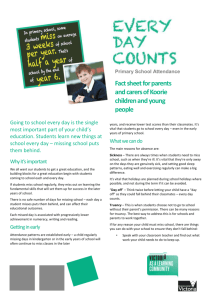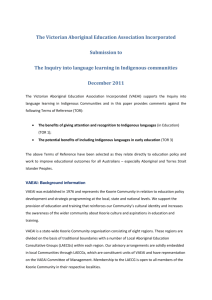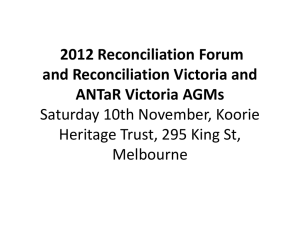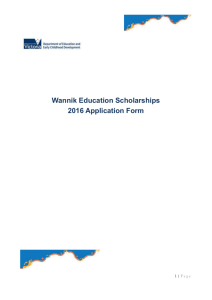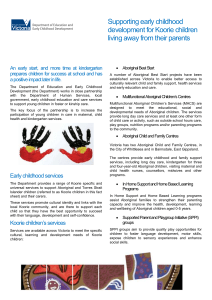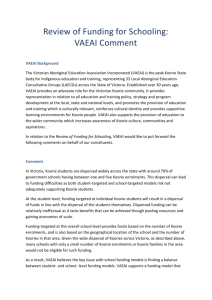Childcare and Early Childhood Learning
advertisement
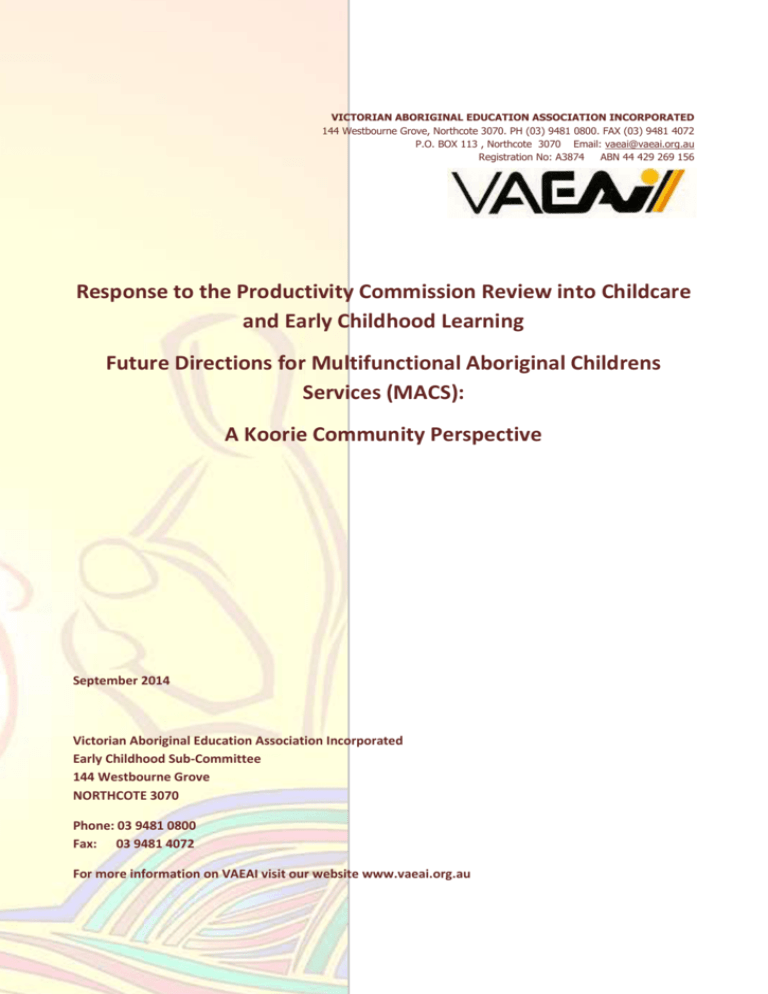
VICTORIAN ABORIGINAL EDUCATION ASSOCIATION INCORPORATED 144 Westbourne Grove, Northcote 3070. PH (03) 9481 0800. FAX (03) 9481 4072 P.O. BOX 113 , Northcote 3070 Email: vaeai@vaeai.org.au Registration No: A3874 ABN 44 429 269 156 Response to the Productivity Commission Review into Childcare and Early Childhood Learning Future Directions for Multifunctional Aboriginal Childrens Services (MACS): A Koorie Community Perspective September 2014 Victorian Aboriginal Education Association Incorporated Early Childhood Sub-Committee 144 Westbourne Grove NORTHCOTE 3070 Phone: 03 9481 0800 Fax: 03 9481 4072 For more information on VAEAI visit our website www.vaeai.org.au 1 About VAEAI VAEAI was established in 1976 by Koorie parents who wanted a say in their children’s education. From that beginning VAEAI has become a Statewide organisation. Today VAEAI represents Koorie communities as the peak Koorie community organisation for education and training in Victoria. Our purpose is getting better education outcomes for Koorie people. VAEAI works across all sectors: from early childhood to schools and higher education/training. We provide community based advice to government and education providers. At the same time, we keep the Koorie community informed of opportunities in education. One of the major strengths of VAEAI is its local membership. VAEAI has 32 Local Aboriginal Education Consultative Groups (LAECGs) based across Victoria. LAECGs are voluntary bodies made up of a broad range of local Koorie community members. LAECGs are dedicated to improving the education opportunities of Koorie people in their local communities 2 Introduction This paper from the Victorian Aboriginal Education Association Incorporated (VAEAI) is a response to the Productivity Commissions 2014 Review into Childcare and Early Childhood Learning. The response has been prepared under the advice and direction of VAEAI’s early childhood subcommittee. It is informed by the perspectives of Koorie community members who have direct experience in the early childhood sector, amounting to decades of collective knowledge. The response is particularly focused on the future directions for Multifunctional Aboriginal Children’s Services (MACS). This is an issue of high concern for VAEAI and the Koorie community. MACS are highly regarded by Koorie communities across Victoria as places that promote Koorie culture in the early years. The current environment early childhood policy and program development across Australia is one of intensive scrutiny and review. MACS have of course been impacted by this review environment. This paper will consider: 1. What reviews have the ECH services (including MACS) been subject to in 2014, and what have been the findings of these reviews? 2. What should the future funding and regulatory model for the MACS look like? And, most importantly: 3. How can the MACS continue to best serve the needs of Koorie children and families? Purpose of the MACS Multifunctional Aboriginal Children Services are non-profit community based services established to meet the social and developmental needs of Aboriginal and Torres Strait Islander children. Care includes Long Day Care, occasional care, Kindergarten, playgroups, vacation care and cultural programs. MACS provide quality care, and are place for children to be safe, have a healthy meal, become school ready, play/socialise, and keep their culture strong. MACS are licensed, have the full quota of qualified staff (in some cases exceeding the quota) and operate under the Early Years Learning Development Framework (EYLDF). From July 2014 MACS are required to provide a Quality Improvement Plan under the National Quality Standard. 3 History Multifunctional Aboriginal Children’s Services (MACS) were established as a national early childhood program with Commonwealth funding in 1987, with seven established in Victoria and six currently operating. The MACS that is no longer operating was in Bairnsdale – at that site the Dala Yooro Children and Family Centre was established in 2014. The MACS policy and funding framework was established by the Federal Government in 1987. Prior to the MACS program framework being established most communities were supporting play groups and child care often without government funding. Six of the seven MACS funded were operating before the MACS program was established. Yappera (Thornbury) – 1980 Lidje-(Mooroopna) – 1981 Bung Yarnda (Lake Tyers) – 1987 Bairnsdale – (1983) Gunai Lidj (Morwell)– 1987 Berrimba (Echuca) –1974 (as a playgroup) Murray Valley Child Care Centre (Robinvale) – 1986 Bung Yarnda (Lake Tyers) was purpose built in 1987 under the MACS model. Funding Models in ECH services BBF Model When the MACS were first established in 1987 the funding model was a combination of the following: 1. Operational subsidy 2. Childcare subsidy based on block funding 85% of licensed places 3. Special services funding eg. Vehicles/OSHC/ Outreach/Camps That changed in 2003 when MACS moved to being administered under the Budget Based Funding (BBF) program which provides an annual block allocation of funding. With the exception of Consumer Price Index (CPI) increases, the block allocation to the MACS has not increased since 2003. MACS have received infrastructure funding specifically to expand the capacity of the services to offer places, but not a funding increase for number of licensed places. 4 For example Lulla’s has received infrastructure funding so that it is now a 70 place centre, but still only receives funding for 17 places. The static nature of the block based funding has made it very difficult for the MACS to expand the number of places they offer to Koorie families in response to demand. BBF programs can be broadly grouped into five main types: centre-based services, including Multifunctional Aboriginal Children’s Services, crèches and flexible/innovative services outside school hours care and enrichment programmes Indigenous playgroups mobile child care services, including those that visit regional and remote areas and provide flexible children’s sessions, playgroups, vacation care, on-farm care, or parenting support other services, for example nutritional programmes, toy libraries and school lunch services Child Care Benefit Model The funding model for the BBF services, being block based, is very different from mainstream ECH services, which operate on the Child Care Benefit (CCB) model. The CCB model is a per child model where the government subsidises the cost of child care for the family. The CCB model is means tested, but in addition through the Child Care Rebate the Federal government refunds 50% of out-of-pocket expenses to parents/caregivers up to a maximum of $7500.00 per annum. VAEAI estimates that under the CCB/CCR model parents/caregivers would be paying double what they currently pay under the BBF model. The CCB system offers fulltime subsidised care only to parents who have passed a work/activity test. Non working parents are entitled to a maximum of 29 hours of care. If MACS were moved to the CCB system, this would be a serious issue, with parents not in employment or training very much affected. Furthermore the MACS philosophy is that the centre serves the needs of the child, and does not discriminate between working/non-working parents. What reviews have the ECH services (including the MACS) been subject to in 2014, and what has been the impact of these reviews? The ECH sector has been subject to a number of reviews in 2014 by government agencies in recent times, reviews which all MACS have been included in. 5 These reviews are part of an overall increased focus in Australian early childhood policy and program development on standards, regulation, and productivity. Reviews include: Australian Government Department of Education Review of Budget Based Funding Programme, May 2014 (MACS) Federal Budget 2014- early childhood program funding Productivity Commission Report into Chilcare and Early Childhood Learning (November 2013- draft report released July 2014) Australian Government Department of Education Review of National Quality Framework (2014) Australian Government Department of Education Review of Budget Based Funding Programme, May 2014 (MACS) In June 2014 The Assistant Minister for Education, the Hon Sussan Ley M released the findings from the Budget Based Funded (BBF) Programme Review. The review made a number of recommendations about the future of the BBF programme. Assistant Minister Ley has agreed to the implementation of recommendations relating to: a new outcomes based performance framework introduction of a quality improvement strategy to further improve quality service delivery in BBF services streamlining some administrative arrangements from 1 July 2014. These changes will coincide with new funding agreements for BBF services which will not be released until the Productivity Commissions review is final (end of October 2014). One important result of the BBF Review is that all BBF services (including the MACS) will be required to complete a Quality Improvement Plan. The Quality Improvement Plan must correspond to the National Quality Standard and the Early Years Learning Development Framework. However services will not be assessed under the National Quality Framework, because the Framework is directly tied to CCB funding. All MACS are supported in their professional development by an Indigenous Professional Support Unit (IPSU) under the Australian Government Department of Education’s Inclusion and Professional Support Program (IPSP). As VAEAI is currently coordinating the IPSU program in Victoria, VAEAI will be assisting the MACS with their Quality Improvement Plans in 2014. 6 Federal Budget 2014- early childhood program funding The Indigenous Professional Support Program (IPSP- which includes IPSU) will be subject to budget cuts through changes to the administration of the program which will take effect from 1 July 2016. The nature of the savings will be determined by the outcome of the Productivity Commission Review. Savings of $3.7 million will be made by suspension of funding for three years from 2015-16 for professional development of staff in Budget Based Funded child care services In real terms, the professional development of the MACS will not be impacted by the budget changes because MACS will be able to access PD through the Professional Support Coordinator (PSC) alliance. The PSC will have increased capacity to support the MACS because providers that are not BBFs (i.e services operating with CCB funding) will accesss their Professional Development through the Long Day Care Professional Development Program (LDCPDP) funding.\ Australian Government Department of Education Review of National Quality Framework (2014) A Review of the National Quality Framework for Early Childhood Education and Care Services is being undertaken by the Australian Government and all states and territories in 2014 to monitor the implementation of the NQF. The Review will seek to identify what is working well, areas for improvement and any unintended consequences that result from implementation of the National Quality Framework. BFF services are currently exempt from the National Quality Framework, but in 2014 there have been the beginnings of some appraisal of whether some MACS will be able to transition over to the NQF (along with moving to a mainstream funding model). Yappera and Lulla’s were appraised in 2014 as to their suitability to transition to the NQF. Both services were appraised as meeting the standards or above. As a result of the appraisal Yappera’s was selected for a viability study to assess the capacity of the service to move to mainstream funding arrangements. Productivity Commission Report into Chilcare and Early Childhood Learning (November 2013- draft report released July 2014) The Productivity Commissions draft report has recommended that Government assistance should focus on three priority areas: 7 Mainstream support should be a single child-based subsidy that is: means- and activity- tested, paid directly to the family's choice of approved services, for up to 100 hours per fortnight, and based on a “reasonable cost” of delivering ECEC for each age of child in different ECEC types. In regional, rural and remote areas with fluctuating child populations, viability assistance should be provided on a limited time basis. Children with additional needs should have access to a 'top-up' subsidy to meet the additional reasonable costs of service. Services should have access to assistance to build capacity to provide ECEC for: individual additional needs children, for children in highly disadvantaged communities and to facilitate the integration of ECEC with schools and other services. The Australian Government should continue to support the states and territories for all children to attend an approved preschool program in the year prior to school. The BBF Programme currently block funds services in rural and remote areas, with around 80 per cent providing services for Indigenous children. The Productivity Commission recommends that: child-based mainstream funding is a more sustainable long term funding model for many ECEC providers. “In principle, all providers who receive block funding will transition to the mainstream funding. However, in some areas families will find it difficult to meet the activity test due to the lack of a labour market in their area. Hence it will be challenging for some services, particularly those in remote communities, to transition to mainstream arrangements. Such services should continue to receive block funding, but be subject to review, and some co-payment by families introduced where possible.” Future funding model for the BBF services look like? VAEAI agrees with the Productivity Commission’s recommendation that Child Care Rebate and Child Care Benefit should be combined into a single, child based subsidy. VAEAI is concerned however that all BBF services would be expected to transition to mainstream arrangements with the exception of services assessed as being in disadvantaged locations. Indigenous disadvantage is well established, and in order to close the gap there should be a unified effort to promote success for all Aboriginal and Torres Strait Islander children, regardless of where they live. A BBF service, including MACS, may be situated where there is a viable labour market, but this does not mean that the parents/caregivers of children attending the centre do not continue to experience social and economic disadvantage. 8 The Productivity Commission recommends a single, means tested subsidy which would provide more support for low and middle income families, covering up to 90 per cent of costs. VAEAI recommends the following model for MACS: A single, child based subsidy that covers the cost of 90 per cent of all licensed places for each MACS centre, based on the real cost of care. An additional loading that covers the centre costs of infrastructure, transport, meals for children, parent/caregiver information sessions, and promotion of early childhood education. VAEAI also believes that this model of funding should be extended to the Aboriginal Children and Family Centres, which are also providing culturally inclusive support to Koorie children in Victoria. How can MACS continue to best serve the needs of Koorie children and families? After many years of advocacy and promotion we are now reaching a breakthrough point in the Koorie early years area. Pre-school participation continues to increase for Koorie children, and is approaching parity with the non-Koorie population.There is greater awareness of the importance of the early years in the Koorie community than ever before. There are also areas which continue to require concerted effort in Koorie early years. School readiness, as measured by the Australian Early Years Development Index in Grade Prep, continues to lag behind for Koorie children. Koorie children need the ongoing delivery of early years services that are high quality, and promote self confidence and school ready socialisation. MACS are a success story for the Koorie community in Victoria. Many were founded out of necessity. As VAEAI early childhood committee members Aunty Melva Johnson, Aunty Rose Bamblett and Geraldine Atkinson note, the MACS in Echuca and Shepparton were established in the seventies the because local kindergartens in the area reserved only one spot for Koorie children. This policy had numerous ill-effects: a dearth of places, a forced dispersal of Koories, and a deterrence to attend early childhood services for Koorie families in Echuca and surrounding areas. While social attitudes have largely changed a lot in the 30+ years since MACS was founded, the necessity for dedicated Koorie early childhood services remains, albeit for different reasons. Today dedicated Koorie early childhood centres are places of cultural identity and pride. The Koorie children attending these centres are encouraged to develop their burgeoning 9 understanding of Koorie identity and belonging. This understanding, which of course begins in the family, is reinforced by the centre and is something that Koorie children can take into their school life with confidence. VAEAI believes that all Koorie children should be able to attend a dedicated early childhood service, but realistically the resources are not available for this - particularly given the highly dispersed nature of the Koorie population in Victoria. In the absense of available/accessible places dedicated Koorie early years centres should be resouced and supported as early years cultural hubs that other generalist early childhood services can learn from. Currently dedicated early years services barely receive adequate funding to cover the cost of servicing the children and families that attend these services. This is a wasted opportunity, when there is a strong foundation to use these services as places of learning for all early childhood centres across the State. 10
